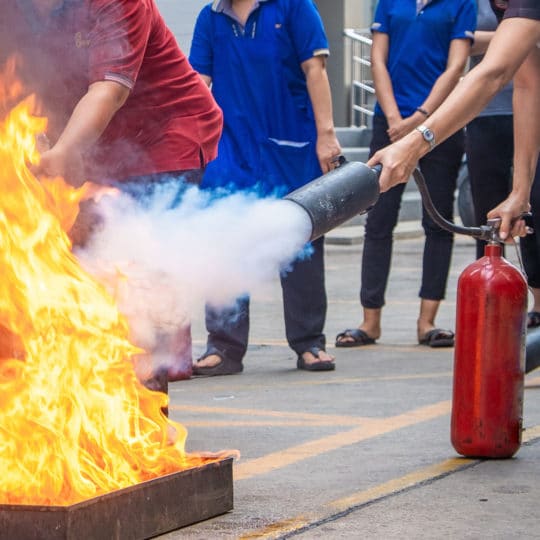Fire Extinguishers
What Type to Use & How

A fire extinguisher. You’ve heard of it, know what it’s used for, and have even probably seen one mounted to a wall somewhere. But do you know how to properly use it? Or that there are different types for different kinds of fires? Now you know.
Choosing the Right Fire Extinguisher
Since not all fires are started the same way, not all extinguishers are the same. There are different types used for different kinds of fires that should be kept in certain areas. Using the wrong class of extinguisher not only won’t put out the fire, but it may also make it worse. The following classification is the system used in the U.S.
- Class A. A water and foam-based extinguisher used for putting out fires involving ordinary solid combustibles, such as wood, cloth, and paper products.
- Class B. When flammable liquids and gases are involved, use a dry chemical extinguisher.
- Class C. Electrical fires also require a dry chemical extinguisher. Anything containing water should not be used to put out this type of fire, as it can lead to electrocution.
- Class D. When flammable metals ignite, use a dry powder extinguisher to remove the heat element or separate fuel from oxygen.
- Class K. Use wet chemical extinguishers for oil and grease fires. Most commercial kitchens require this tool to be close by. This is another case where you should never use water, as it can cause the flames to explode and spread.
Most likely, the fire extinguisher you have in your home and see in public spaces is a Class ABC dry chemical extinguisher. This combination is suitable for putting out fires on wood and paper, flammable liquids, and electrical. There should be one on every level of your home—especially in the kitchen.
How to Use a Fire Extinguisher
After you’ve found the right extinguisher, get familiar with how to use it. If it’s been sitting around, out of use for a while (thank goodness) check to make sure the pressure is still in the green zone, there’s no broken seal or hoses, and there’s no dents, leaks, or rust. Know what the range is on your extinguisher—it can be anywhere between six and 20 feet. You want to stay at a safe but effective distance.
Fire extinguishers are designed to put out fires that have just started. Any blaze that’s taller than you or has already spread throughout the room is too much for a portable extinguisher. If it’s still manageable, position yourself with your back to an unobstructed exit so that you can get out quickly if needed. Now, get ready to PASS!
- Pull the pin.
- Aim the nozzle at the base of the fire to get in contact with what started it and smother it.
- Squeeze the trigger in a controlled manner to release the agent.
- Sweep from side to side until the fire is out.
Other Helpful Tips
Knowing what to do before there’s an emergency will better prepare you to deescalate the situation. One of the worst things that can happen is for a fire to spread while you search for an extinguisher or fumble through the instructions. Here are some other things to keep in mind:
- Keep extinguishers out of reach of children, away from heating appliances, or behind curtains. The best place to keep one is mounted to a wall by an exit.
- Even when the fire appears to be extinguished, keep an eye out for hidden hot spots that could reignite.
- Once used, either recharge the extinguisher—no matter how long you’ve used it—or replace altogether.
Contact Security Five for more information on the best fire extinguishers to use and systems to put in place for your safety.